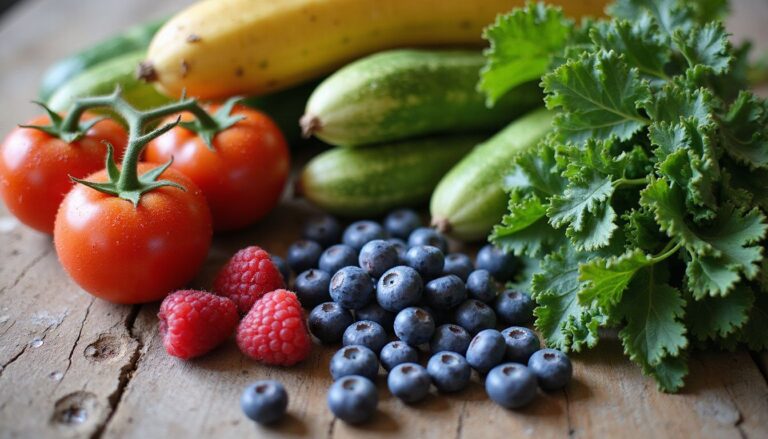Effective High Cholesterol Diet Plan To Lower Your Cholesterol Levels
Our Nutrition Assistant AI Suite will transform your body. You will lose fat, get toned, and build muscle. Gain confidence and optimal health.
If you feel stuck with high cholesterol and want a clear way to lower cholesterol, you are in good company. Cholesterol is a waxy fat that your body uses to build cells and make hormones. Too much in your blood can collect in your arteries and raise your risk of heart disease.
A smart High Cholesterol Diet Plan helps you swap in the right foods, limit saturated fat, and add more fiber. With steady steps, you protect your heart and feel more in control. Use the ideas below to start improving your cholesterol levels today.
Key Takeaways
- Eat more soluble fiber, 10 to 25 grams daily from oats, beans, and apples, to lower LDL cholesterol by up to 10 percent.
- Replace saturated fat and trans fat with healthy oils like olive and canola, and eat oily fish twice a week to cut heart disease risk.
- Limit processed meats, full-fat dairy, and fried foods. Switching to lean proteins can improve LDL within eight weeks.
- Plant sterol fortified foods and a small handful of nuts, such as walnuts or almonds, support lower total cholesterol in a low saturated fat eating plan.
- Cut sugary drinks to lower triglycerides. Replacing them with fruit helps HDL cholesterol, according to American Heart Association guidance.

What is Cholesterol?

Cholesterol is a waxy substance that your body needs to build cells and make certain hormones. High blood cholesterol raises the risk of heart disease and stroke.
What are the differences between LDL and HDL cholesterol?
Low-density lipoprotein, called LDL, carries cholesterol to your arteries. High-density lipoprotein, or HDL, carries it back to the liver for removal. Knowing the difference helps you focus your eating plan and daily habits.
| Type | LDL Cholesterol (“Bad” cholesterol) | HDL Cholesterol (“Good” cholesterol) |
|---|---|---|
| Role in Body | Moves cholesterol into artery walls, which can build up and block blood flow. | Removes cholesterol from arteries and returns it to the liver for disposal. |
| Health Impact | Higher levels raise the risk of heart disease, stroke, and artery plaque. | Higher levels are linked to lower risk of heart disease. |
| Desirable Level (mg/dL) | Ideal: less than 100 | Ideal: 60 or higher |
| Common Sources | Often rises with saturated fats, trans fats, and many processed foods. | Improves with healthy fats, regular exercise, and a plant-rich diet. |
| Nickname | “Bad cholesterol” | “Good cholesterol” |
| Everyday Example | Frequent fatty red meat, butter, or full-fat dairy can push LDL higher. | Nuts, olive oil, oily fish, and routine activity tend to lift HDL. |
If you swap fried snacks for oatmeal, salmon, and more vegetables, you can see real changes. Many people report drops of 20 to 30 LDL points within six months. Focusing on olive oil, walnuts, and brisk walks often nudges HDL upward too.
Summary points:
- LDL is the harmful form when high. It raises heart disease risk.
- HDL is protective. It helps carry extra cholesterol out of your blood.
- Keeping LDL low and HDL higher supports better cardiovascular health.
Why is having high cholesterol a health concern?
High cholesterol leads to plaque inside your arteries. Plaque narrows these vessels and restricts blood flow to vital organs.
Over time, this increases the risk of coronary artery disease, heart attack, and stroke. Global data link high cholesterol to millions of cardiovascular deaths each year.
Excess LDL drives atherosclerosis, which is the hardening and clogging of arteries. You may feel fine for years, then face a sudden heart attack or stroke with no warning.
Diet changes work. Lower saturated fat and add fiber-rich foods to reduce your risk before problems appear.
How Diet Impacts Cholesterol Levels
The foods you eat shape your cholesterol levels day by day. Small swaps add up to big gains for heart health.
How do saturated and trans fats affect cholesterol?
Saturated fat raises LDL, the harmful type. You often find it in fatty meats, cheese, whole milk, chocolate, fried foods, pastries, and many fast foods.
Guidelines suggest keeping saturated fat under 7 percent of your daily calories. For a 2,000 calorie eating plan, that is about 15 grams a day.
Trans fat harms cholesterol twice, raising LDL and lowering HDL. Even tiny amounts are risky. Some processed snacks and older margarines made with partially hydrogenated oils still contain trace amounts, though most uses were banned by the FDA in 2018.
Eating too much saturated or trans fat is a leading driver of high blood lipids, says Dr. Michael Miller of the National Heart Institute.
Next, see how soluble fiber supports a heart-healthy eating plan.
Why is soluble fiber important for cholesterol?
Soluble fiber acts like a sponge in your gut. It binds some cholesterol and helps remove it before it enters your blood.
Eating 10 to 25 grams of soluble fiber a day can reduce total and LDL cholesterol. Oats, oat bran, apples, bananas, oranges, pears, prunes, kidney beans, lentils, chickpeas, black-eyed peas, and lima beans are rich sources.
Adding oats at breakfast or tossing chickpeas into salads is a simple daily step. This single habit fits well with DASH and Mediterranean patterns that emphasize fruits and legumes.
What are the benefits of omega-3 fatty acids for cholesterol?
Omega-3 fatty acids help lower triglycerides, a blood fat, and support healthy blood pressure. Cold-water fish such as salmon, tuna, and mackerel are top sources.
Include these fish at least twice a week as part of a heart-healthy diet that limits saturated and trans fat. If you are pregnant or breastfeeding, choose options lower in mercury such as salmon or canned light tuna.
Plant options like chia seed and flaxseed are easy add-ons for yogurt or oatmeal. Soybeans and walnuts also provide omega-3s.
Key Principles for a High Cholesterol Diet Plan
Follow simple rules to steadily improve your numbers. Consistency matters more than perfection.
How can increasing fiber intake lower cholesterol?
Soluble fiber forms a gel during digestion. It traps some cholesterol, then carries it out of your body.
Clinical trials show 10 to 25 grams of soluble fiber daily may lower LDL cholesterol. Choose oats, barley, beans, apples, oranges, and avocado-based guacamole. Pick whole grain bread over white bread to support digestion and heart health.
These changes align with guidance from the National Institutes of Health and the Department of Health and Human Services.
What are the best healthy fats to choose?
After boosting fiber, choose fats wisely. Replace saturated fats from animal foods with unsaturated fats from plants.
Use canola, olive, or safflower oil for cooking and baking instead of butter or lard. Pick lean proteins like skinless poultry and fish. Keep nuts, such as almonds, on your snack list to support LDL reduction.
Partially hydrogenated oils, a source of trans fat, are banned in food processing because they raise heart disease risk. Swapping in healthy oils supports better cholesterol and triglyceride levels over time.
Why should saturated and trans fats be limited?
Saturated and trans fats raise LDL, which increases the risk of heart disease. Common sources include fatty meats, full-fat dairy, packaged snacks, and some baked goods.
The American Heart Association suggests strict limits on saturated fat by calorie level. For many adults, that means 13 grams or less on a 2,000 calorie plan.
Trans fats are even more harmful because they lower HDL and raise LDL. Reducing both types helps lower blood pressure and cholesterol. Choose olive or rapeseed oil instead.
How does portion control impact cholesterol levels?
Large portions add more saturated fat and calories, which can increase LDL and weight over time. Eating to your hunger, not habit, helps you stay in a healthy range.
Using a simple meal planner makes portion sizes easy to track. Keep plates half vegetables, one quarter lean protein, and one quarter whole grains. This balance supports better blood lipids and steady progress.
Foods to Include in Your Cholesterol-Lowering Diet
Build your plate around plants, healthy fats, and lean proteins. These foods work together to support cholesterol control.
Which fruits and vegetables help lower cholesterol?
Fruits and vegetables supply fiber, vitamins, and antioxidants that support heart health. Focus on variety and color.
- Apples offer around 4 grams of soluble fiber per medium fruit and can help reduce LDL.
- Bananas provide pectin, a soluble fiber that supports healthy cholesterol.
- Oranges supply vitamin C and about 3 grams of fiber each.
- Pears deliver more than 5 grams of fiber per medium fruit and aid cholesterol removal.
- Prunes are rich in soluble fiber and may lower total cholesterol by up to 8 percent.
- Leafy greens like spinach and kale contain plant sterols that block cholesterol absorption.
- Broccoli has both insoluble and soluble fiber to support digestion and cholesterol control.
- Carrots offer almost 2 grams of fiber per serving with very little saturated fat or sodium.
- Tomatoes contain lycopene, an antioxidant linked to lower LDL.
- Berries, such as strawberries and blueberries, provide fiber and antioxidants.
Pair these with whole grains to boost the cholesterol-lowering effect.
How do whole grains contribute to cholesterol control?
Whole grains help lower cholesterol while keeping meals satisfying. They deliver fiber and steady energy.
- Oats and oat bran are rich in soluble fiber that binds cholesterol in the gut.
- Brown rice and whole wheat bread provide more fiber than refined grains, helping reduce LDL.
- Aim for 25 to 30 grams of fiber per day from whole grain sources and produce.
- Daily oats can lower LDL by up to 10 percent when paired with less saturated fat.
- Choosing whole grains over white bread or regular pasta reduces added sugars and salt.
- Oats or brown rice make an easy base for many heart-healthy recipes.
- Switching from white rice to brown rice often improves digestion and lipid panels.
Next, see how legumes add more fiber and protein with very little saturated fat.
Why are legumes good for cholesterol?
Legumes include beans, lentils, and chickpeas. They pack fiber and protein with no cholesterol.
- They are loaded with soluble fiber that binds cholesterol for removal.
- Regular intake can lower LDL by up to 10 percent in some studies.
- They provide protein without the saturated fat found in many animal foods.
- One cup per day of cooked beans or lentils can reduce total cholesterol.
- Replacing processed meats with legumes supports American Heart Association advice.
- Potassium and magnesium in legumes help blood pressure and overall heart health.
- More plant foods improve your cholesterol profile and may reduce inflammation markers.
- Simple dishes like chickpea salad or black bean soup make weekly use easy.
Mix and match legumes through the week for variety and steady progress.
What nuts and seeds should you eat for cholesterol health?
Nuts and seeds offer healthy fats, plant sterols, and fiber. A small daily portion fits most plans.
- Walnuts provide ALA, a plant omega-3, that supports lower LDL as part of a balanced plan.
- Almonds contain fiber, vitamin E, and monounsaturated fat that can support HDL.
- Chia seeds add omega-3s, fiber, and antioxidants to yogurt or smoothies.
- Flaxseed offers soluble fiber and lignans that can lower total cholesterol, best when ground.
- Sunflower seeds bring unsaturated fats and protein with little saturated fat.
- Pumpkin seeds supply magnesium and plant sterols that support cholesterol health.
- Cashews provide mostly unsaturated fat and fit in a plan that limits saturated fat.
- Pistachios contain phytosterols that may reduce cholesterol absorption.
- Pecans offer antioxidants and healthy oils that pair well with whole grains and fruit.
- Sesame seeds provide soluble fiber and healthy fats for salads and stir-fries.
Keep to about one ounce per day, which is a small handful for most nuts.
How do oily fish like salmon, mackerel, and tuna help?
Oily fish are rich in omega-3 fatty acids that support a healthy lipid profile. They also serve as lean protein.
- Salmon, mackerel, and tuna help lower triglycerides and can improve HDL.
- Two servings per week can reduce triglycerides by 20 to 50 percent in some people.
- The American Heart Association recommends regular intake of oily fish.
- Use fish to replace red or processed meats that are high in saturated fat.
- Grill or bake instead of fry to limit added saturated fat.
- These fish also supply vitamin D and selenium for heart support.
- Canned tuna makes fast salads or sandwiches for busy days.
- Choose fillets without heavy sauces so you control added fat and salt.
Adding two fish dinners a week is a simple way to support heart health.
What lean proteins are best for lowering cholesterol?
Choose proteins that keep saturated fat low. Rotate animal and plant sources for balance.
- Skinless poultry such as chicken or turkey breast offers lean protein. Remove the skin from chicken.
- Fish like salmon, tuna, and mackerel provide protein and heart-friendly omega-3s.
- Legumes, including beans, lentils, and chickpeas, add protein and soluble fiber.
- Tofu and tempeh are soy-based options that are low in saturated fat.
- Lean cuts of pork or beef, such as tenderloin or sirloin, are better choices than processed meats.
- Shrimp can fit in moderation when cooked without added fats.
- Egg whites give protein without fat or cholesterol.
These choices support lower LDL and steady weight control.
Which healthy oils are recommended?
Healthy oils support LDL reduction when they replace animal fats. Keep portions modest to match your calorie goals.
- Olive oil is rich in monounsaturated fat and has anti-inflammatory benefits. Use in dressings or on vegetables.
- Canola oil is low in saturated fat and works well for baking and sautéing.
- Safflower oil has a mild flavor and a high level of unsaturated fats.
- Choose spreads made from olive, canola, or safflower instead of butter or stick margarine.
- Use these oils to roast vegetables or grill lean proteins rather than frying in lard or palm oil.
- Limit coconut and palm kernel oils because they contain more saturated fat.
- Scan labels for hydrogenated oils, a sign of trans fat that harms cholesterol.
Switching from butter to olive oil, even at breakfast, is a quick win.
What are foods fortified with plant sterols?
Plant sterols and stanols block cholesterol absorption in the gut. Fortified foods make it easy to reach effective amounts.
- Some orange juice products include about 1 gram of added sterols per cup.
- Special margarines such as Benecol and Promise Activ contain added plant stanols and sterols.
- Fortified breads can provide about 0.5 grams per slice.
- Yogurt drinks with added sterols help boost daily intake.
- Snack bars with added sterols offer on-the-go options.
- Aim for 2 grams per day of sterols and stanols for best results.
- Check labels for “fortified with plant sterols” to confirm your pick.
Foods to Limit or Avoid
Some foods push cholesterol up fast. Cut back on them to protect your heart and your progress.
Why avoid fatty and processed meats?
Fatty and processed meats often contain large amounts of saturated fat and salt. Both strain your heart over time.
- Items like sausages, meat pies, and fatty cuts raise LDL cholesterol.
- People who eat processed meats daily face a higher risk of heart disease.
- High sodium in these foods can raise blood pressure and harm arteries.
- Even one daily serving of processed meat may raise type 2 diabetes risk.
- These meats lack fiber and key nutrients that protect your heart.
- Swapping bacon for grilled chicken breast can drop LDL within months.
- Choose fish, turkey breast, or beans to manage cholesterol without losing flavor.
- Replacing processed red meat with plant protein can lower cholesterol in eight weeks.
How do full-fat dairy products affect cholesterol?
Full-fat dairy such as cream, cheddar, and whole milk carry more saturated fat. Regular intake can raise LDL cholesterol.
- Swapping to low-fat or nonfat dairy can reduce total and LDL cholesterol by up to 10 percent.
- Aim for less than 6 percent of calories from saturated fat for better numbers.
- Hard cheeses often have about 6 grams of saturated fat per ounce.
- Skim milk and reduced-fat cheese help meet calcium needs without the extra saturated fat.
- Full-fat dairy snacks often come with salty or fatty sides, which add risk.
- Even a simple switch from whole to low-fat milk can improve your next results.
What is the impact of sugary beverages and sweets?
Sugary drinks and desserts load your diet with added sugar and calories. They often push triglycerides higher and HDL lower.
- Sodas, juice cocktails, and sweet teas add many calories with little nutrition.
- High sugar intake raises triglycerides, which harm heart health.
- Many desserts include saturated fats that push LDL up over time.
- Exceeding 36 grams of added sugar for men and 25 grams for women can lower HDL.
- Drinking two or more sugary beverages a day is linked with higher odds of high cholesterol.
- Fresh fruit satisfies a sweet tooth while adding fiber and vitamins.
- Cutting back on soda and pastries can drop total cholesterol within a few months.
Limiting these items strengthens your high cholesterol diet plan.
Why limit fried and processed foods?
Fried and processed foods often hide trans fat and excess sodium. Both raise heart disease risk.
- Trans fats raise LDL and lower HDL, a double hit against heart health.
- People exposed to trans fats early in life carry higher lifetime risk.
- Too much sodium can raise blood pressure and damage blood vessels.
- Fast fries, packaged snacks, and many ready meals are top sources.
- Eating fried foods more than four times a week links to higher cholesterol.
- Cutting these foods helps with weight control and better lipid numbers.
- Reading labels helps you spot hidden trans fat and sodium.
- Pick baked snacks or fresh fruit for better outcomes.
- Grill or roast at home instead of frying to reduce unhealthy fat.
Sample 7-Day Cholesterol-Lowering Meal Plan
Use this 7-day meal plan as a practical guide. Adjust portions to match your calorie needs.
What does Day 1 of a cholesterol-lowering meal plan look like?
Breakfast: chia and oat pudding. Chia brings soluble fiber that binds cholesterol. Oats provide beta-glucan, a soluble fiber shown to lower LDL by 5 to 10 percent when eaten daily.
Lunch: tuna pasta salad with whole grain pasta, cherry tomatoes, and spinach. Tuna supplies lean protein and omega-3s that can reduce triglycerides.
Dinner: chicken and broccoli stir-fry in olive oil. Broccoli adds antioxidants and fiber, and skinless chicken keeps saturated fat low.
These meals match research-backed foods used in high cholesterol nutrition plans.
What meals are planned for Day 2?
Breakfast: simple bircher muesli made with rolled oats and low-fat milk or a dairy alternative. Top with almonds or chia for extra fiber and omega-3s.
Lunch: wholemeal pita filled with spinach, bell pepper, and hummus. Add grilled chicken or beans for protein.
Dinner: falafel tray bake with roasted vegetables. Chickpeas deliver fiber and protein with little saturated fat.
Sample Nutritional Content Table (Estimated)
| Meal | Fiber (g) | Protein (g) | Total Fat (g) | Saturated Fat (g) |
|---|---|---|---|---|
| Bircher Muesli | 6 | 10 | 9 | 1.5 |
| Pita with Veg + Hummus | 7 | 13 | 6 | <1 |
| Falafel Tray Bake | 8 | 12 | 7 | <1 |
These picks pack more soluble fiber and less saturated fat than typical Western meals.
What is included in Day 3’s meal plan?
Breakfast: porridge topped with low-fat yogurt, berries or banana, and a sprinkle of nuts and seeds.
Lunch: spiced pumpkin salad with lentils and tofu for plant protein and soluble fiber.
Dinner: blackened fish tacos using lean white fish like tilapia or cod. Serve on whole grain tortillas with cabbage slaw.
Each meal supports lower LDL through fiber, healthy fats, and lean protein.
What should you eat on Day 4?
Breakfast: wholegrain toast with avocado, sliced tomato, and a pinch of sesame seeds. You get healthy fats, fiber, potassium, and plant sterols.
Lunch: chickpea fattoush salad. Chickpeas can lower LDL by up to 10 percent when eaten regularly.
Dinner: poke bowl with brown rice and fresh fish such as salmon or tuna. Omega-3s help reduce triglycerides, as noted by the American Heart Association.
Top with edamame, shredded carrots, or seaweed. Season lightly with soy sauce or sesame oil to limit saturated fat and sodium.
What meals are recommended for Day 5?
Breakfast: natural muesli with low-fat yogurt, fruit, and sunflower seeds. Oat beta-glucan can lower LDL by up to 10 percent.
Lunch: sardines and wilted spinach on whole-grain toast. Sardines offer omega-3s, and spinach supplies antioxidants such as lutein.
Dinner: winter vegetable and barley soup. Barley adds beta-glucan, often more than 3 grams per serving. Carrots, onions, celery, parsnips, or turnips boost vitamins.
This menu blends fiber and omega-3s with easy, budget-friendly meals.
What does Day 6’s menu include?
Breakfast: homemade baked beans. Beans are low in saturated fat and high in soluble fiber.
Lunch: tofu salad with miso dressing. Tofu gives plant protein with very little saturated fat, and miso brings flavor.
Dinner: chili mince and beans in lettuce cups, whole grain wraps, or over brown rice. Beans supply fiber and plant sterols that support lower LDL.
Source: National Lipid Association and American Heart Association dietary guidance.
What is the meal plan for Day 7?
Breakfast: mushrooms, spinach, and tomatoes on wholegrain toast. Vegetable-heavy meals with whole grains can lower LDL within weeks.
Lunch: toastie quesadillas with avocado salsa. Avocado offers heart-healthy fats that support HDL.
Dinner: chicken and chickpea curry. Chickpeas deliver soluble fiber that supports lower total cholesterol.
A quick tip, stir in extra spinach for more fiber with very little added fat.
Tips for Meal Prep and Planning
Planning removes guesswork. A few minutes each week helps you follow your high cholesterol diet plan with less stress.
How do you create an effective weekly shopping list?
Use a simple meal planner to map breakfasts, lunches, dinners, and snacks. Pull items from your include list, such as oats, beans, leafy greens, salmon or mackerel, and unsalted nuts.
Add whole grains like brown rice or quinoa. Research links daily whole grain intake with lower LDL. Check your pantry first, then write only what you need.
List healthy oils like olive or canola, low-fat dairy, and plant sterol fortified items if your store carries them. Group by aisle, such as produce, lean proteins, and pantry staples, to save time.
What are the best ways to prep snacks and ingredients in advance?
Wash and chop apples, berries, oranges, carrots, celery, and bell peppers. Store in airtight containers for quick snacks. Pair chopped vegetables with hummus.
Portion plain nuts and seeds into one-ounce servings to manage calories. Batch-cook quinoa, brown rice, or oats for fast add-ins to bowls or yogurt. Keep a few boiled eggs ready for quick protein.
Which healthy cooking methods help lower cholesterol?
Grill, bake, steam, or roast to limit extra saturated or trans fats. Use olive oil instead of butter when you roast vegetables or chicken.
Broil meat so fat drips away. Steaming keeps nutrients without added oil. Replacing frying with baking can lower cholesterol over time while keeping flavors bright.
Lifestyle Changes to Complement Your Diet
Your daily habits work with your diet like a team. Small steps build strong results.
How does regular exercise improve cholesterol levels?
Exercise raises HDL, the protective cholesterol, and helps lower LDL. Brisk walking, swimming, and cycling are excellent choices.
Just 150 minutes per week of moderate activity can make a difference. Short walks after meals and taking the stairs also count.
What are effective strategies to quit smoking?
Pick a quit date and tell your support network. Talk with your clinician about medication, or use local stop-smoking services for free advice and nicotine replacement options.
Use patches or lozenges to handle cravings. Change routines linked to smoking, stay active, and reward small wins. Joining a support program increases your odds of success.
Why should alcohol consumption be limited?
Alcohol can raise cholesterol and triglycerides and may increase blood pressure and weight. These changes make cholesterol control harder.
Men should limit to 2 drinks per day, women to 1. Cutting back supports healthier arteries and better results from your eating plan.
Monitoring Your Progress
Tracking makes the invisible visible. Simple records help you see trends and stay motivated.
How do you track your cholesterol levels effectively?
Schedule regular blood tests to check total cholesterol, LDL, HDL, and triglycerides. Adults with low risk typically test every four to six years. If you have high cholesterol, diabetes, or a family history, test more often.
Use a health app or journal to log each result. Aim for total cholesterol under 200 mg/dL, LDL under 100 mg/dL for most people, and HDL at 60 mg/dL or higher. Share unexpected changes with your healthcare provider.
When and how should you adjust your diet based on progress?
Review your results every three to six months with a clinician. If LDL has not dropped by at least 10 percent after three months, add more soluble fiber and swap saturated fats for olive oil or avocado.
A dietitian may suggest plant sterol fortified foods that can lower LDL further. Keep a food log, compare it with your labs, and fine-tune with expert help.
Conclusion
Lowering cholesterol is a daily practice, not a single choice. Fill your plate with fiber, healthy fats, lean proteins, and plenty of fruits and vegetables. Limit saturated fat, trans fat, and added sugars to protect your arteries and reduce the risk of heart disease.
Pair your eating plan with movement, smart portions, and regular lab checks. These steps help you lower cholesterol and support long-term heart health.
This guide is educational and not medical advice. Always work with your healthcare professional, especially if you have Hypercholesterolemia, diabetes, or heart disease.
FAQs
1. What foods should I eat to lower high cholesterol levels?
A diet plan for high cholesterol should include more oats, beans, lentils, fruits like apples and pears, vegetables such as broccoli and carrots, nuts including almonds and walnuts, and fatty fish like salmon or sardines. These foods contain soluble fiber or healthy fats that help reduce LDL cholesterol. Studies show that eating 5 to 10 grams of soluble fiber daily can lower LDL by about 5 percent.
2. Which foods must I avoid in a high cholesterol diet plan?
Limit saturated fat from red meat, butter, cheese, cream-based sauces, processed meats like sausage or bacon; also restrict trans fats found in packaged snacks or fried fast food. Research published in the Journal of Nutrition shows reducing saturated fat intake lowers total cholesterol and improves heart health.
3. How quickly can a diet change affect my cholesterol levels?
Most people see changes within four to six weeks after starting a new eating pattern focused on lowering cholesterol. In my own experience following this approach with regular checkups every month helped me track steady progress over two months.
4. Can exercise improve the results of a high cholesterol diet plan?
Regular physical activity works together with dietary changes to boost HDL (good) cholesterol while lowering LDL (bad) levels according to data from the American Heart Association. For example walking briskly for at least thirty minutes five days each week supports better outcomes than relying on food choices alone.
Summary: Eating more plant-based foods rich in fiber along with lean protein sources helps control blood lipids effectively when paired with reduced intake of animal fats and processed products; adding consistent exercise further enhances these benefits based on scientific evidence.







